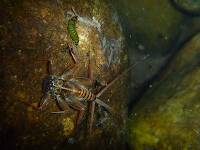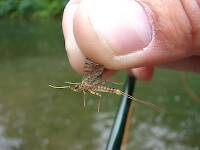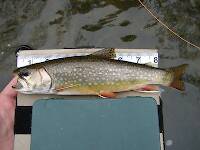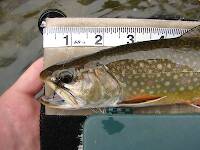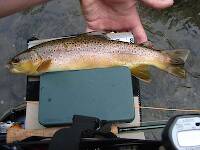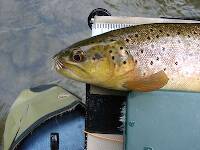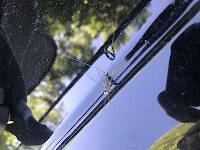
Blue-winged Olives
Baetis
Tiny Baetis mayflies are perhaps the most commonly encountered and imitated by anglers on all American trout streams due to their great abundance, widespread distribution, and trout-friendly emergence habits.
Featured on the forum
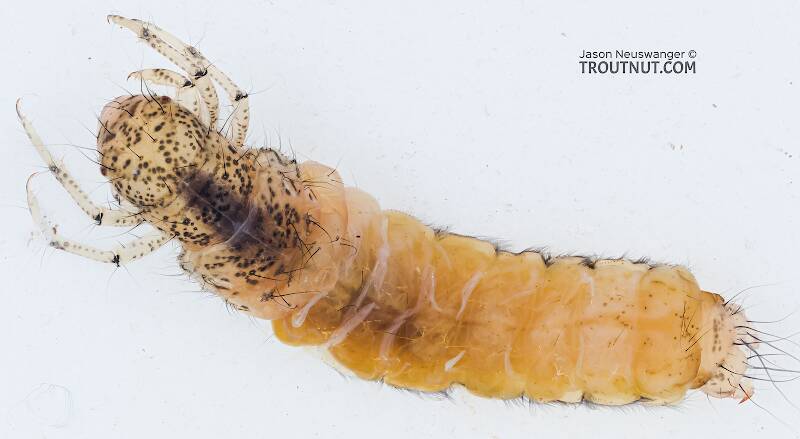
This is a striking caddis larva with an interesting color pattern on the head. Here are some characteristics I was able to see under the microscope, but could not easily expose for a picture:
- The prosternal horn is present.
- The mandible is clearly toothed, not formed into a uniform scraper blade.
- The seems to be only 2 major setae on the ventral edge of the hind femur.
- Chloride epithelia seem to be absent from the dorsal side of any abdominal segments.
Based on these characteristics and the ones more easily visible from the pictures, this seems to be Grammotaulius. The key's description of the case is spot-on: "Case cylindrical, made of longitudinally arranged sedge or similar leaves," as is the description of the markings on the head, "Dorsum of head light brownish yellow with numerous discrete, small, dark spots." The spot pattern on the head is a very good match to figure 19.312 of Merritt R.W., Cummins, K.W., and Berg, M.B. (2019). The species ID is based on Grammotaulius betteni being the only species of this genus known in Washington state.
- The prosternal horn is present.
- The mandible is clearly toothed, not formed into a uniform scraper blade.
- The seems to be only 2 major setae on the ventral edge of the hind femur.
- Chloride epithelia seem to be absent from the dorsal side of any abdominal segments.
Based on these characteristics and the ones more easily visible from the pictures, this seems to be Grammotaulius. The key's description of the case is spot-on: "Case cylindrical, made of longitudinally arranged sedge or similar leaves," as is the description of the markings on the head, "Dorsum of head light brownish yellow with numerous discrete, small, dark spots." The spot pattern on the head is a very good match to figure 19.312 of Merritt R.W., Cummins, K.W., and Berg, M.B. (2019). The species ID is based on Grammotaulius betteni being the only species of this genus known in Washington state.

Troutnut is a project started in 2003 by salmonid ecologist Jason "Troutnut" Neuswanger to help anglers and
fly tyers unabashedly embrace the entomological side of the sport. Learn more about Troutnut or
support the project for an enhanced experience here.
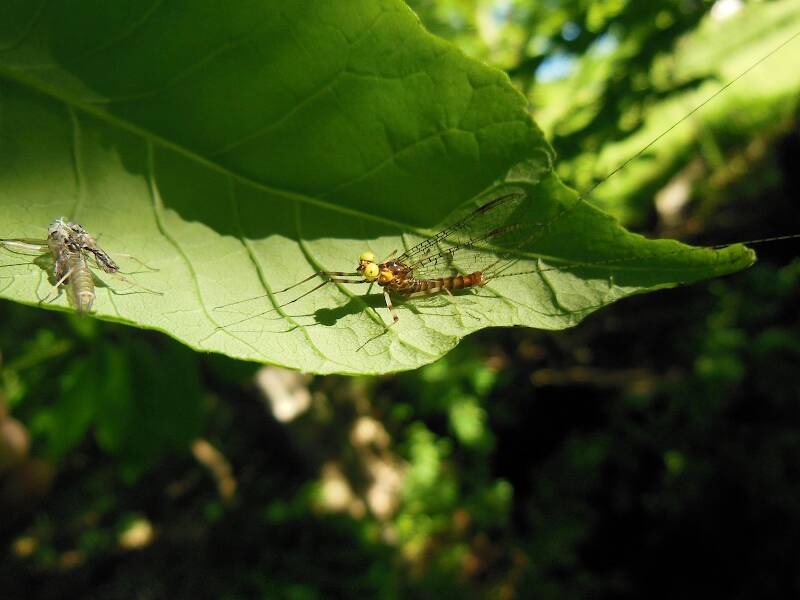
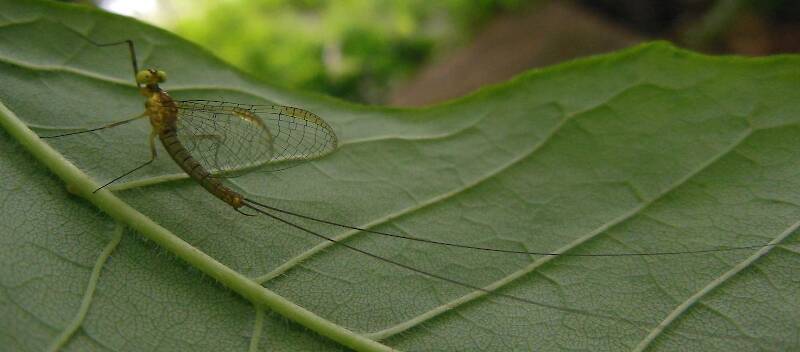
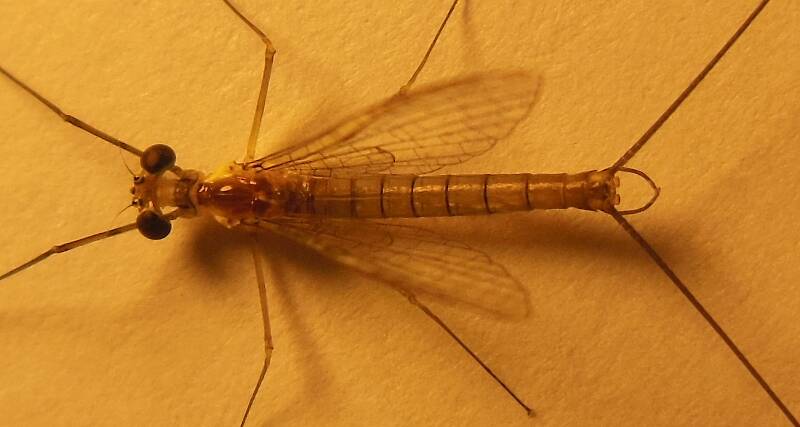
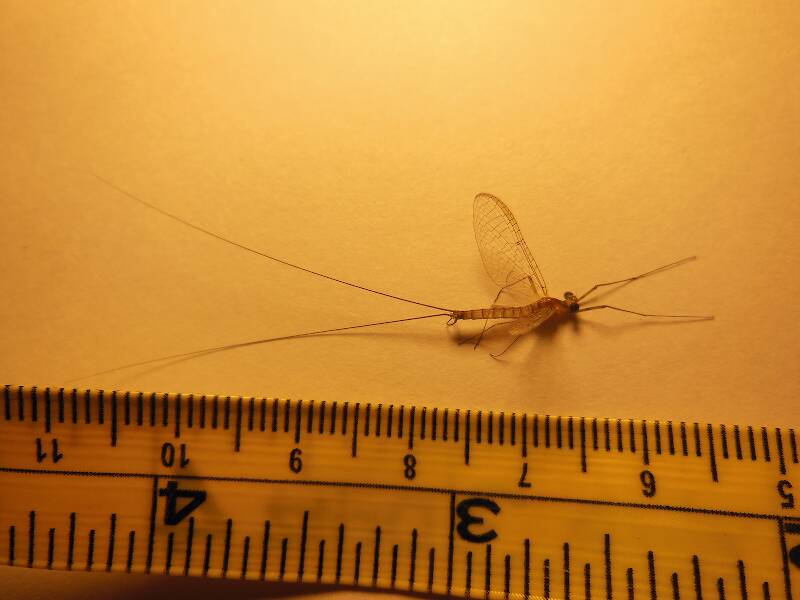
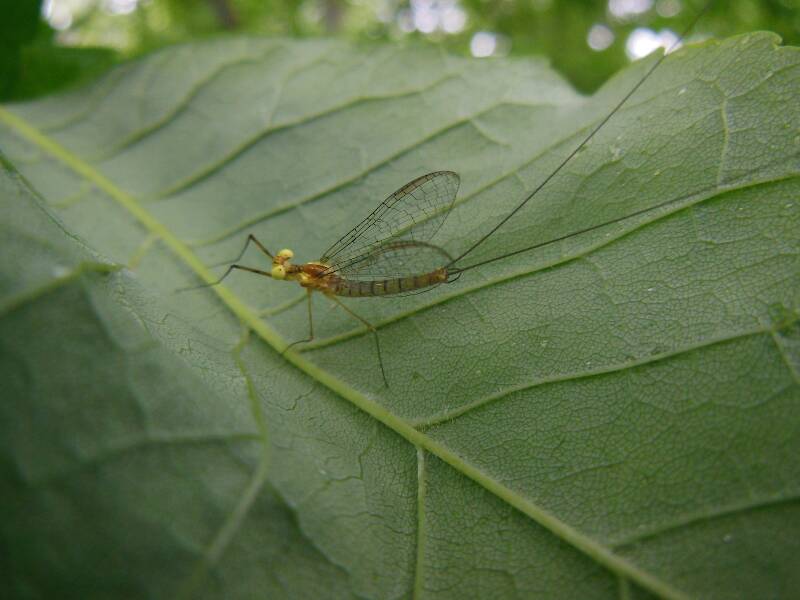
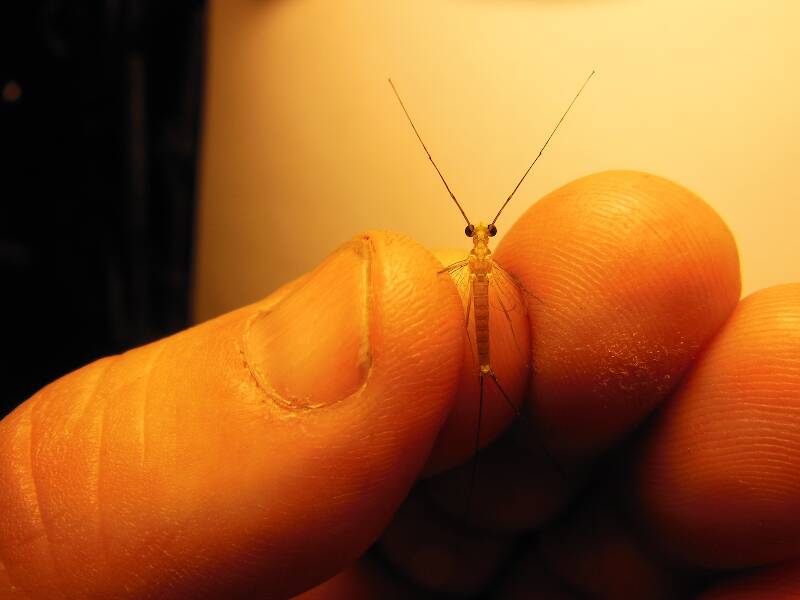
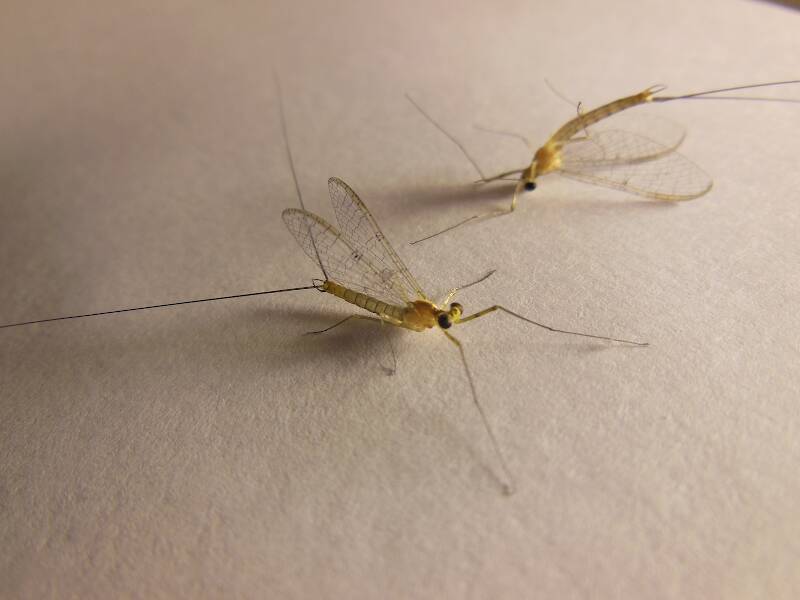

JohnNY
Posts: 15
Posts: 15
JohnNY on Jun 7, 2013June 7th, 2013, 9:05 am EDT
I'd love any opinions(or facts) :) on this fly.
The photos were taken in Central NY. These flies were resting on the undersides of leaves above a VERY small intermittent stream.
Notice the length of the two tails.
Thanks in advance for ANY info.
John
The photos were taken in Central NY. These flies were resting on the undersides of leaves above a VERY small intermittent stream.
Notice the length of the two tails.
Thanks in advance for ANY info.
John
JohnNY
Posts: 15
Posts: 15
JohnNY on Jun 7, 2013June 7th, 2013, 8:43 pm EDT
Thanks for the welcome.
I appreciate your thoughts.
I'm 99% sure that these guys are brothers. Or at least cousins.
They are the same type of bug.
Could the differences you are seeing be explained in the fact that the one is JUST recently emerged from the shuck beside him while the other has been around awhile?
Could you explain your reasons why it is a March Brown and not a Quill Gordon?
Thanks!
I appreciate your thoughts.
I'm 99% sure that these guys are brothers. Or at least cousins.
They are the same type of bug.
Could the differences you are seeing be explained in the fact that the one is JUST recently emerged from the shuck beside him while the other has been around awhile?
Could you explain your reasons why it is a March Brown and not a Quill Gordon?
Thanks!
Entoman on Jun 10, 2013June 10th, 2013, 11:18 am EDT
Hi JohnNY,
Welcome to the forum. Neither are March Browns or Gordon Quills, they are Cahills. Distance between the eyes (precluding the Gordons), tergal pattern (dorsal abdomen), and wing venation point to the genus Maccaffertium in the family Heptageniidae. The first is possiblyy pudicum based on the combination of stained stigmatic region of the forewing, stained hind wing tips, and thick banded terga. The second is maybe luteum based on the sparse cross veins in the bulla region of the forewings, the absence of spiracular dots on the abdomen, and the thin posterior tergal lines. There are other species and even genera that could possibly fit, so a better look at the forelegs, forewing venation and private parts are needed to know for sure.
Welcome to the forum. Neither are March Browns or Gordon Quills, they are Cahills. Distance between the eyes (precluding the Gordons), tergal pattern (dorsal abdomen), and wing venation point to the genus Maccaffertium in the family Heptageniidae. The first is possiblyy pudicum based on the combination of stained stigmatic region of the forewing, stained hind wing tips, and thick banded terga. The second is maybe luteum based on the sparse cross veins in the bulla region of the forewings, the absence of spiracular dots on the abdomen, and the thin posterior tergal lines. There are other species and even genera that could possibly fit, so a better look at the forelegs, forewing venation and private parts are needed to know for sure.
"It's not that I find fishing so important, it's just that I find all other endeavors of Man equally unimportant... And not nearly as much fun!" Robert Traver, Anatomy of a Fisherman
Entoman on Jun 10, 2013June 10th, 2013, 12:11 pm EDT
The tails on # 2 has keep me puzzled by being so dark and most Maccaffertium have pale yellow tails with reddish-brown articulations.
Yes, could be the light. Also, the costal crossveins aren't as well developed as I'm used to seeing and then there's the lack of distinct leg banding as well. Doesn't seem a good fit for the Heptagenia complex of genera, though (but could be).
"It's not that I find fishing so important, it's just that I find all other endeavors of Man equally unimportant... And not nearly as much fun!" Robert Traver, Anatomy of a Fisherman
JohnNY
Posts: 15
Posts: 15
JohnNY on Jun 11, 2013June 11th, 2013, 3:40 am EDT
I added a photo to my initial post that can be enlarged... if it will help.
Thanks.
Thanks.
JohnNY
Posts: 15
Posts: 15
JohnNY on Jun 11, 2013June 11th, 2013, 10:30 am EDT
These guys live 100 feet from my door. If you could think of any other perspectives that may help id them... suggest away. I'm limited by my camera but I can certainly try to get photos that might help. They are flitting around NOW, so time is of the essence. ;)
Entoman on Jun 11, 2013June 11th, 2013, 10:53 am EDT
Thanks for the additional photo, John. Not a Maccaffertium. I am thinking this is the heptageniid Spinadis simplex (because of the extreme eye spread and long pronotum). If I'm right, this is the first picture of a male imago I've seen. They are very rare and not well documented. Also explains why we couldn't make sense of those tails and legs, Mack.:) There is no common name for them though Cahill would fit.
"It's not that I find fishing so important, it's just that I find all other endeavors of Man equally unimportant... And not nearly as much fun!" Robert Traver, Anatomy of a Fisherman
Crepuscular on Jun 11, 2013June 11th, 2013, 12:21 pm EDT
Spinadis simplex is pretty small, and I think they are a big river species. What was the approx. size of this one?
Entoman on Jun 11, 2013June 11th, 2013, 2:28 pm EDT
Rusticus is in the different genus Anepeorus. It is a much darker fly with a pointed snout and eyes closer set. Simplex was reassigned it's own genus quite awhile back. Both genera are monotypical, which is the only reason I mentioned species. If memory serves, Flowers in one of her papers mentions that the long prothorax of S. simplex in conjunction with the wide eye set is quite unique and should be diagnostic. I can't open the doc Mack attached on my road setup, but if I remember it, there's not much mention of maculation other than a few females or ones soaked in alcohol for a very, VERY long time.:) As for size, I seem to remember that they are in the 8mm range? I also remember they like deep moving water (over 4 - 5 ft. deep) with heavy trash like logs and stuff.
I could be all wet of course, but it's fun to speculate.:)
I could be all wet of course, but it's fun to speculate.:)
"It's not that I find fishing so important, it's just that I find all other endeavors of Man equally unimportant... And not nearly as much fun!" Robert Traver, Anatomy of a Fisherman
JohnNY
Posts: 15
Posts: 15
JohnNY on Jun 11, 2013June 11th, 2013, 5:54 pm EDT
If 4-5 feet of water is a prerequisite... they are NOT S.Simplex...
Although these guys are 9mm, they are living in inches of water!
And as I think I stated in the initial post, where I find these guys every year... is an intermittent stream. It has surface flow, reliably from Spring thaw through June. But then it's a crapshoot. It "flows" but not surface flow. It stays WET...lol.
It has at least three different mayflies, three different stones and at least one caddis...
I'm working on more photos...
Thanks again guys...
Although these guys are 9mm, they are living in inches of water!
And as I think I stated in the initial post, where I find these guys every year... is an intermittent stream. It has surface flow, reliably from Spring thaw through June. But then it's a crapshoot. It "flows" but not surface flow. It stays WET...lol.
It has at least three different mayflies, three different stones and at least one caddis...
I'm working on more photos...
Thanks again guys...
JohnNY
Posts: 15
Posts: 15
JohnNY on Jun 11, 2013June 11th, 2013, 6:33 pm EDT
So I posted some more photos.
The last one is to show the "truest" color of the bugs on white paper. They were ALL taken on white paper, but the lighting/camera, well... the last one is the best representation of the color.
I hope the new pics help.
The last one is to show the "truest" color of the bugs on white paper. They were ALL taken on white paper, but the lighting/camera, well... the last one is the best representation of the color.
I hope the new pics help.
Oldredbarn on Jun 11, 2013June 11th, 2013, 7:31 pm EDT
Wonderful pics John...I need to remember my camera the next time out!
Spence
Spence
"Even when my best efforts fail it's a satisfying challenge, and that, after all, is the essence of fly fishing." -Chauncy Lively
"Envy not the man who lives beside the river, but the man the river flows through." Joseph T Heywood
"Envy not the man who lives beside the river, but the man the river flows through." Joseph T Heywood
JohnNY
Posts: 15
Posts: 15
JohnNY on Jun 11, 2013June 11th, 2013, 7:37 pm EDT
So I'm looking at the fourth photo down here: http://www.troutnut.com/specimen/595
and The head/eye placement seem a bit different.
Everything else looks good... but does the color of the tails matter at all?
Thanks for your diligence!
And thanks, Spence!
and The head/eye placement seem a bit different.
Everything else looks good... but does the color of the tails matter at all?
Thanks for your diligence!
And thanks, Spence!
Entoman on Jun 12, 2013June 12th, 2013, 9:42 am EDT
Good thread and interesting critter...:)
The latest pictures show that it clearly isn't Spinadis. The fore tarsi are too long. As for Stenacron, they can have wide set eyes, but I'm only seeing some slight thickening of the crossveins below the bullae in one of the pictures. Even those are not coming close to connecting. In all the other photos there's no differentiation between them and the rest of the crossveins. The long pronotum and lack of spiracular marks on the abdomen are also a bit troubling, as are the lack of bands or spots on the femora. Can anybody contribute some input regarding Leucrocuta and Macdunnoa? I think they are wide eye set critters as well. If I was home...:)
A good close up of the fore tarci would be helpful, John. Particularly the first few segments below the tibia.
The latest pictures show that it clearly isn't Spinadis. The fore tarsi are too long. As for Stenacron, they can have wide set eyes, but I'm only seeing some slight thickening of the crossveins below the bullae in one of the pictures. Even those are not coming close to connecting. In all the other photos there's no differentiation between them and the rest of the crossveins. The long pronotum and lack of spiracular marks on the abdomen are also a bit troubling, as are the lack of bands or spots on the femora. Can anybody contribute some input regarding Leucrocuta and Macdunnoa? I think they are wide eye set critters as well. If I was home...:)
A good close up of the fore tarci would be helpful, John. Particularly the first few segments below the tibia.
"It's not that I find fishing so important, it's just that I find all other endeavors of Man equally unimportant... And not nearly as much fun!" Robert Traver, Anatomy of a Fisherman
JohnNY
Posts: 15
Posts: 15
JohnNY on Jun 12, 2013June 12th, 2013, 10:52 am EDT
A good close up of the fore tarci would be helpful, John. Particularly the first few segments below the tibia.
So, that's the front leg below the knee, right? :)
I'll TRY, but those are TINY. Are you looking for color or structure?
That is, do you think taking a photo on a white background or a slightly colored(darker) one would be best?
Entoman on Jun 12, 2013June 12th, 2013, 11:39 am EDT
Hi John,
What I'm looking for is a comparison of the 1st and 2nd segment lengths of the tarsi (those closest to the tibia). The tarsus begins at what looks like the third leg part. The first long part is the femur, the second long part below the "knee" is the tibia, the third part (made up of five hard to see segs) is the tarsus.
Mack -
Didn't we discuss one of your Stenacron specimens last year where thickened crossveins below the bullae weren't obvious?
What I'm looking for is a comparison of the 1st and 2nd segment lengths of the tarsi (those closest to the tibia). The tarsus begins at what looks like the third leg part. The first long part is the femur, the second long part below the "knee" is the tibia, the third part (made up of five hard to see segs) is the tarsus.
Mack -
Didn't we discuss one of your Stenacron specimens last year where thickened crossveins below the bullae weren't obvious?
"It's not that I find fishing so important, it's just that I find all other endeavors of Man equally unimportant... And not nearly as much fun!" Robert Traver, Anatomy of a Fisherman
Entoman on Jun 12, 2013June 12th, 2013, 12:52 pm EDT
Finally got to a computer that can enlarge your photos, John. I agree with Mack that the specimen next to the ruler and the one in the photo next to the one upside down clearly show the requisite "thickened in the middle" cross veins in the cells below the bullae. Stenacron interpunctatum is the right call. Good job, Mack. I have no explanation for why the specimen in the first photo doesn't have them, nor can I explain the long prothoraxes.
"It's not that I find fishing so important, it's just that I find all other endeavors of Man equally unimportant... And not nearly as much fun!" Robert Traver, Anatomy of a Fisherman
Entoman on Jun 12, 2013June 12th, 2013, 1:34 pm EDT
Sorry Mack, I'm a long way from my library and only have an iphone most of the time to work with (tough, to say the least). That's why I was asking for support from you guys on Macdunnoa!:)LOL Off the top of my head, try Flowers or one of the many papers with McCafferty on the team.
"It's not that I find fishing so important, it's just that I find all other endeavors of Man equally unimportant... And not nearly as much fun!" Robert Traver, Anatomy of a Fisherman
JohnNY
Posts: 15
Posts: 15
JohnNY on Jun 13, 2013June 13th, 2013, 4:56 am EDT
SO...Stenacron interpunctatum it is!?!
The length of the "neck"...
That would be the "prothorax" I take it?
It is substantialy longer than what I see in the specimen I see here on the website.
I obviously can't compare actual lengths, but as a percent of the width of some structures there in the prothorax/head, my specimen's measurements (ratio of the length of some structures to the width of some)is 24-35% greater than the one specimen shown here on this website.
Is that just "normal" variation that one might find within ANY species of bug? These guys are kind of living off the beaten path; could this just be a genetic variation due to natural selection and genetic isolation over a few decades?
Thanks you for ALL of your efforts to satisfy MY curiosity. If you're not careful, I'll be posting another mystery... Hopefully, a less dificult one...
The length of the "neck"...
That would be the "prothorax" I take it?
It is substantialy longer than what I see in the specimen I see here on the website.
I obviously can't compare actual lengths, but as a percent of the width of some structures there in the prothorax/head, my specimen's measurements (ratio of the length of some structures to the width of some)is 24-35% greater than the one specimen shown here on this website.
Is that just "normal" variation that one might find within ANY species of bug? These guys are kind of living off the beaten path; could this just be a genetic variation due to natural selection and genetic isolation over a few decades?
Thanks you for ALL of your efforts to satisfy MY curiosity. If you're not careful, I'll be posting another mystery... Hopefully, a less dificult one...
Lastchance on Dec 24, 2013December 24th, 2013, 5:07 am EST
OK I know now for sure the genus and species and they love that kind of water.
They are Stenacron I see the black spots in the mid area of the forewing towards the front edge. I will look at my specs to ad the species in a half hour. I spent all winter studying this group in great detail.
So, these are Light Cahills?
Quick Reply
Related Discussions
Topic
Replies
Last Reply
4
May 24, 2008
by Softhackle
by Softhackle
8
Mar 30, 2012
by Brookyman
by Brookyman
0
Oct 19, 2006
by GONZO
by GONZO





